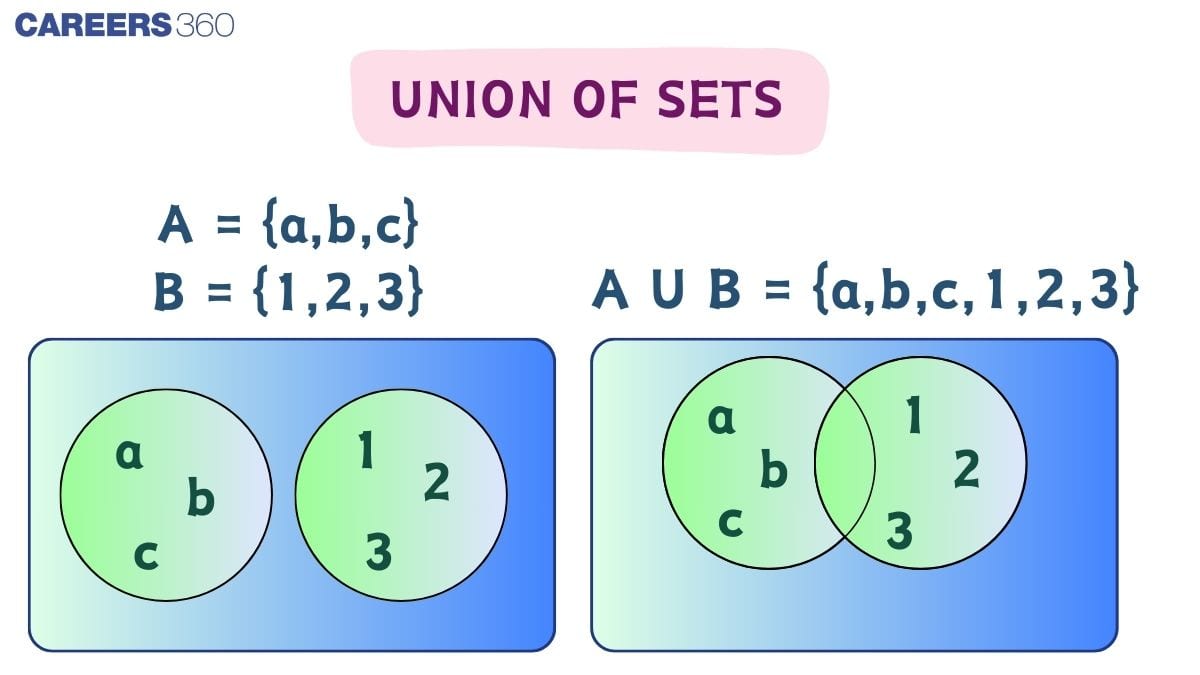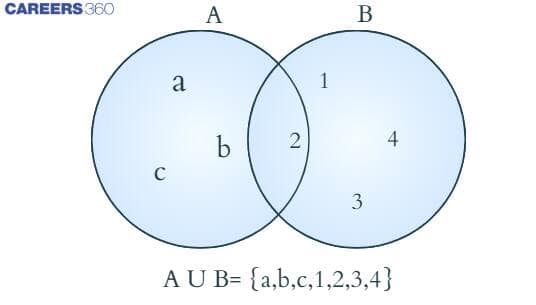Union of sets, Properties of union
Consider two sets: the set of all students scoring above 50% and the set of all students scoring below 51%. When combined, we get the set of all students in the class. This process of combining two or more sets without duplication is called the union of the sets. The union of sets is one of the most important operations in set theory, used to combine all unique elements from two or more sets into a single set. It plays a key role in mathematics, data analysis, logic, and computer science by helping us understand how groups of elements relate and overlap. The union operation is represented using the symbol $\cup$, and it ensures that each element appears only once in the resulting set, even if it is repeated across the original Sets. In this article, we will explain the definition, notation, properties, Venn diagram representation, and examples of the union of sets.
This Story also Contains
- Union of Sets Definition
- A Union B Formula
- Properties of the Union of Sets
- Solved Examples based on Union of Sets
- List of Topics Related to the Union of Sets
- NCERT Resources
- Practice Questions on Union of Sets

Union of Sets Definition
A set is simply a collection of distinct objects, considered as a whole. These objects, called elements or members of the set, can be anything: numbers, people, letters, etc. Sets are particularly useful in defining and working with groups of objects that share common properties.
The union of sets represents the combination of all elements of two or more sets.
Let $A$ and $B$ be any two sets. The union of sets $A$ and $B$ is the set that combines the elements in both sets without duplication. In other words, the union includes every distinct element that belongs to either $A$ or $B$.
Notation of the Union of Sets
Specific symbols are used to represent different operations. The symbol used for the union of two sets is ‘$\cup$’, which stands for union. This is known as infix notation, meaning the symbol is placed between the two sets involved in the operation.
Symbolically, we write $A \cup B=\{x: x \in A$ or $x \in B\}$.
This means any element that is a member of set $A$, set $B$, or both will be included in the resulting set $A \cup B$.
Union of Sets Examples
1. If $A=\{1,3,5,7\}$ and $B=\{2,4,6,8\}$ then $A \cup B$ is read as $A$ union $B$ and its value is, $A \cup B=\{1,2,3,4,5,6,7,8\}$
2. If If $A=\{d, e, g, y, c\}$ and $B=\{a,s,d,f\}$ then $A \cup B=\{a,c,d,e,f,g,s,y\}$
Union of Sets Venn Diagram
Let $A$ and $B$ be any two sets. The union of sets $A$ and $B$ is the set that combines the elements in both sets without duplication. The union of sets is denoted by '$\cup$ '.
Symbolically, we write $\mathrm{A} \cup \mathrm{B}=\{\mathrm{x}: \mathrm{x} \in \mathrm{A}$ or $\mathrm{x} \in \mathrm{B}\}$.
The Venn diagram of the union of sets is

A Union B Formula
The union of sets A and B refers to a set that includes all elements that are in A, in B, or in both. It is written as $A \cup B$ and is read as ”A union B” or ”A or B.” This formula is used to find the combined elements of sets A and B, without repeating any element.
Mathematically, the union of A and B is defined as: $A \cup B=\{x: x \in A$ or $x \in B\}$.
Formula for Number of Elements in A union B
Consider two sets, A and B. To determine the cardinal number of the union of these sets, we say
$n(A \cup B) = n(A) + n(B) - n(A \cap B)$
Here,
$n(A \cup B)$ = Total number of elements in $A \cup B$.
$n(A)$ = Number of elements in $A$.
$n(B)$ = Number of elements in $B$.
$n(A \cap B)$ = The number of elements that are common to both $A$ and $B$ also called the cardinality of set $A \cap B$, i.e. $A$ intersection $B$
Properties of the Union of Sets
Below are the properties of union of sets discussed in detail:
1. Commutative Property: This signifies that the union of sets is independent of interchangeable properties.
$A \cup B=B \cup A$
2. Associative Property: This signifies that the union of three sets can be interchangeable.
$(A \cup B) \cup C=A \cup(B \cup C)$
3. Law of identity element: When we take the union of a finite set from a null set, the original set comes ( $\varphi$ is the identity of Null Set).
$\mathrm{A} \cup \varphi=\mathrm{A}$
4. Idempotent Property: This signifies that the union of the same set is itself.
$A \cup A=A$
5. Property of universal set: When we take union from a universal set then a universal set will come.
$U \cup A=U$
Note: If $A$ is a subset of $B$, then $A \cup B=B$
6. The union of any two sets results in a completely new set that contains the elements present in both the initial sets.
7. The resultant set contains all elements present in the first set, the second set, or elements in both sets.
8. The union of two disjoint sets results in a set that includes elements of both sets.
9. According to the commutative property of the union, the order of the sets considered does not affect the resultant set.
10. Cardinality of the Union of two sets is always less than or equal to the sum of the cardinalities of the two sets themselves.
$n(A \cup B)$ $<=n(A)+n(B)$
Solved Examples based on Union of Sets
Example 1: If set $\mathrm{A}=\{1,3,5\}$ and $\mathrm{B}=\{3,5,7\}$. Also $P=A \cup B$ and $Q=B \cup A$. Then which of the following is true?
1) $P=Q$
2) $P \subset Q$
3) $P \neq Q$
4) $Q \subset P$
Solution
In this Question,
As $A \cup B=B \cup A$
So, $P=Q$.
Hence, the answer is option 1.
Example 2: If $A=\{5,6,7\}$ and $B=\{\}$, then the value of $A \cup B$ is
1) \{\}
2) $\phi$
3) $\{5,6,7\}$
4) $\{5\}$
Solution
$\mathrm{A} \cup \varphi=\mathrm{A}$
Using this property, the union in this question will be $\{5,6,7\}$.
Hence, the answer is the option 3.
1) $U$
2) $B$
3) None of these
4) Both (1) and (2)
Solution
Let A and B be any two sets. The union of A and B is the set which consists of all the elements of A and all the elements of B, the common elements being taken only once.
And $A ∪ A = A$
In this Question,
$\begin{aligned} & B=\left\{x: x^2-5 x+6=0 \text { or } x^2-5 x+4=0\right\} \\ & x^2-5 x+6=0 \Rightarrow x=2,3 \\ & x^2-5 x+4=0 \Rightarrow x=1,4 \\ & \Rightarrow B=\{1,2,3,4\}\end{aligned}$
Thus $A = B$
Thus $A \cup B=A=B$
Hence, the answer is option 3.
Solution
$ \begin{aligned} & n(A \cup B)=n(A)+n(B)-n(A \cap B)=12+9-4=17 \\ & n(A \cup B)^{\prime}=n(U)-n(A \cup B)=20-17=3 \end{aligned} $
Hence, the answer is 3.
Example 5: Find the union of the sets $\{3,7,9\},\{5,8,1\}$ and $\{2,8,3\}$.
1) $\{1,2,3,4,5,8,7,9\}$
2) $\{1,2,3,5,7,8,9\}$
3) $\{1,2,3,4,7,8,9\}$
4) $\{1,2,5,7,8,9\}$
Solution
The union of these three sets is the set containing all the elements in these three sets. Option (2) is correct.
Options (1) and (3) have 4, which is not present in any of the given sets.
Option (4) is missing 3.
Hence, the answer is option 2.
List of Topics Related to the Union of Sets
Understanding the union of sets becomes easier when you're familiar with the foundational set theory topics that support it. This section lists essential concepts like roster and set-builder form, intersection, complement, power set, and more that are directly linked to mastering union operations in mathematics.
NCERT Resources
Accessing the right NCERT resources for Class 11 Sets can significantly improve your understanding of the topic. This section provides high-quality study materials including NCERT solutions, revision notes, and exemplar problems to support effective exam preparation.
NCERT Solutions for Class 11 Chapter 1 Sets
Practice Questions on Union of Sets
Mastering any mathematical concept comes through continuous practice. To help strengthen your understanding of the topic, we have given below some practice questions on Union of sets. They will test your knowledge of formulas, important properties and general application of knowledge.
Union of Set - Practice questions
You can practice the next topics of Sets below:
Frequently Asked Questions (FAQs)
Let $A$ and $B$ be any two sets. The union of sets $A$ and $B$ is the set that combines the elements in both sets without duplication. The union of sets is denoted by '$\cup$ '.
$\cap$ represents the intersection of two sets while $\cup$ represents the union of two sets.
The complement of a set simply means all elements having any relations to the universal set without contacting the elements of the given set.
$A \cup B$ represents the union of the sets $A$ and $B$.
The formula for the union of sets is $n(A \cup B)=n(A) + n(B) -n(A \cap B)$